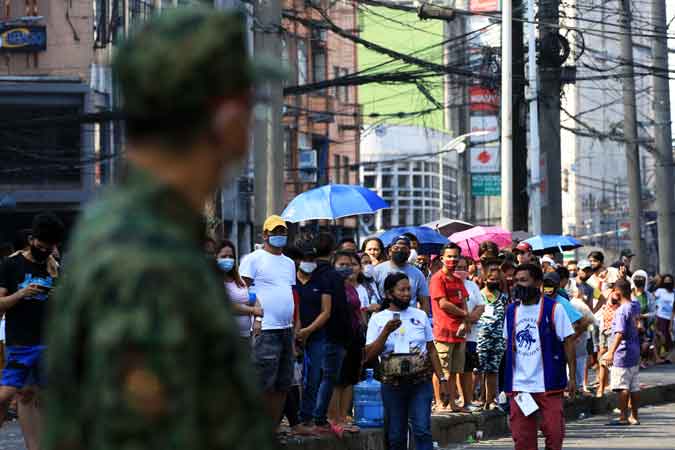By Kyle Aristophere T. Atienza and Vann Marlo M. Villegas, Reporters
THE PHILIPPINE government will deploy more policemen on the streets to enforce health protocols amid a fresh surge in coronavirus infections in Manila, the capital, and nearby cities, according to the Interior and Local Government department.
About 180 more cops had been deployed in Pasay City to help local authorities enforce quarantine rules, Interior Undersecretary Jonathan E. Malaya told a televised news briefing on Tuesday.
More cops will be sent to the cities of Navotas and Malabon to ensure people follow health protocols especially in coronavirus hotspots, he added.
Mr. Malaya said Interior officer-in-charge and Undersecretary Bernardo C. Florence, Jr. gave the order after a meeting with Metro Manila chiefs and the Health department.
“The instruction from OIC Florence was to add more policemen in different parts of Metro Manila, he said.
Former Social Welfare Secretary Judy M. Taguiwalo on Monday criticized the Duterte administration for militarizing a public health issue.
More than 120,000 violators of quarantine protocols were arrested in the Philippines during the lockdown, United Nations High Commissioner for Human Rights Michelle Bachelet said last year.
The list included aid distributors, jeepney drivers, rallyists and other sectors critical of the slow delivery of social services during the pandemic.
Several countries including the Philippines have used the pandemic to harass journalists, opposition activists, health workers and “anyone else who dares to criticize the official response to the coronavirus,” according to Human Rights Watch.
Health Secretary Francisco T. Duque III said coronavirus cases in Metro Manila were a cause for alarm.
The cities of Pasay and Malabon were at a critical risk level, while Navotas, Makati and San Juan were high-risk areas, he said at a televised meeting with President Rodrigo R. Duterte on Monday night.
Coronavirus cases in the Philippine capital and nearby cities have been rising faster, hitting levels last seen in July, according to a group of researchers.
There had been 1,025 infections daily in the capital region in the past seven days, 42% higher than a week earlier and more than double the number two weeks ago, the OCTA Research Group from the University of the Philippines said on Sunday.
The number could still go up this month.
Health Undersecretary Maria Rosario S. Vergeire on Monday said the rise could have been due to Filipinos ignoring health protocols.
More than 120,000 violators of quarantine protocols were arrested in the Philippines, which had one of the strictest and longest lockdowns in Southeast Asia.
The Interior and Local Government department earlier authorized local governments to crack down on quarantine violators.
TALLY
The Department of Health (DoH) reported 2,668 coronavirus infections on Tuesday, bringing the total to 600,428.
The death toll rose by seven to 12,528, while recoveries increased by 171 to 546,078, it said in a bulletin.
There were 41,822 active cases, 91.6% of which were mild, 3.9% did not show symptoms, 1.8% were critical, 1.9% were severe and 0.8% were moderate.
DoH said three duplicates had been removed from the tally, while two recovered cases were reclassified as deaths. Eight laboratories failed to submit data on Mar. 8.
About 8.5 million Filipinos have been tested for the COVID-19 virus as of Mar. 7, according to DoH’s tracker website.
The coronavirus has sickened around 117.8 million and killed more than 2.6 million people worldwide, according to the Worldometers website, citing various sources including data from the World Health Organization (WHO).
About 93.5 million people have recovered, it said.
Meanwhile, the WHO said the rising number of coronavirus infections in the country might not be entirely due to the spread of more contagious variants.
This is given the limited testing for these variants, WHO Country Representative Rabindra Abeyasinghe told an online news briefing.
“Part of the surge we are seeing within the National Capital Region (NCR) may be attributed to the presence of these new variants,” he said.
“But we believe that it’s not entirely being driven by the new variant because the number of cases detected and confirmed as opposed to the number of samples checked is limited,” he added.
Mr. Abeyasinghe said the WHO was still studying the new variants “to understand and describe the implications of increased transmissibility” and severity of cases.
Local health authorities on Friday reported 31 new cases, 28 of whom had addresses in Metro Manila and three others were still under verification, with the more contagious variant first detected in the United Kingdom, bringing the total to 118.
It also reported 52 more infections of the variant first reported in South Africa, 41 of which were from Metro Manila while the rest were still being verified, bringing the total to 58.
Mr. Abeyasinghe said the WHO has observed a community level transmission in Metro Manila, Central Luzon and the Calabarzon region since July last year.
While the country has been reporting more than 3,000 cases daily in the past few days, this is still “significantly lower” than the more than 6,000 cases reported at the height of the pandemic, he said.
The increase in cases should also not be considered as a “second wave.”
“If you’re talking of the second wave, we should have seen a complete flattening of the curve. And in the case of NCR, we didn’t see that kind of flattening,” he said.

